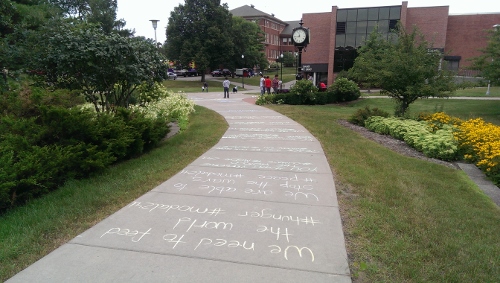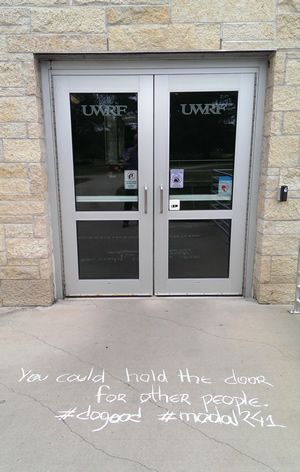Social Modals and Social Media for Promoting #SocialChange
by Conan Kmiecik
 Background
Background
Sometimes bad news can serve as the inspiration for a good classroom activity! In the summer of 2014, while teaching a 6-week intermediate grammar course, I started to become disheartened by the international events that were dominating the news coverage: the kidnapping of school girls in Nigeria, the downing of a Malaysian airplane in the Ukraine, the conflict in Gaza, and the rise of ISIS-sponsored violence in Iraq. However, despite the bleakness of the news, I was inspired to create an activity that would teach students about social modals and encourage them to promote social change using social media.
My students, at the time, were learning about social modals (advice, regret, permission, necessity, and obligation), and I was trying to create an activity to use in conjunction with the lessons in the course workbook. The grammar course met twice a week for 5 hours each day, so it was important the activity provide the students with a break from book learning and exercises. I wanted them to utilize technology, get some fresh air, move around, and be creative. Therefore, on one evening, I conducted a little research about hashtags for social change, created a handout, and spent US$4 for two containers of sidewalk chalk at Target. I was then ready to spend an hour of the next day testing out my activity before the class lunch break.

Students’ messages for social change line the sidewalk.
Handout
After our day’s lesson on social modals, I provided my students with a handout. On one side of the handout, there was the following set of instructions and graphic organizer:
Instructions
- Look over the list of social change #hashtags. Choose 5 that you feel are important.
- Write one message that promotes social change for each #hashtag. However, each message needs to use a different modal!
- After you have drafted your message, write your messages on a sidewalk somewhere on campus.
- Take a picture of one of your messages and post it to the class Facebook group page or to a social media site, like Instagram or Twitter.
- Don’t forget to include the #hashtag of the cause.
|
Hashtag |
Modal |
Message |
|
1. |
|
|
|
2. |
|
|
|
3. |
|
|
|
4. |
|
|
|
5. |
|
|
On the backside of the handout, I provided students with a list of “50 Hashtags to Spark Social Change” from the website Your Public Interest Registry. The website provides a nice array of hashtags for promoting various issues, such as #climate, #education, #fairtrade, #green, #humanrights, and #women. The variety of issues ensured that each student could find several that they cared about.
Sequence of the Activity
First, when all the students had a copy of the handout, I told them, “There are a lot of things that are not going right in the world, but that is no reason to be pessimistic. We all have the power to spark change. What problems in your country or in the world are you concerned about?” After a brief discussion of their concerns, I directed them to look at the list of hashtags. I then asked them to select the hashtags of five issues that they cared about and were willing to promote. They then wrote the hashtags for their issues in the first column of the graphic organizer.
 The students next selected five modals, or modal-like expressions, from the day’s lesson that they would use to develop messages. The social modals (advice, regret, permission, necessity, and obligation) worked perfectly well for promoting messages of social change. While students were thinking about how to create a message for their issues using a particular modal, I walked around the class and made sure that none of them were repeating a formulaic sentence using the same modal in order to speed through the activity. For example, “You should care about the environment. #green”, “You should care about women. #women”, “You should care about the climate. #climate”, and so on. Thankfully, the students were motivated to champion issues that they had chosen and were working quite hard to create interesting messages. Consequently, as I moved around the class, I spent my time helping students with the grammar of their sentences instead of policing them to try harder.
The students next selected five modals, or modal-like expressions, from the day’s lesson that they would use to develop messages. The social modals (advice, regret, permission, necessity, and obligation) worked perfectly well for promoting messages of social change. While students were thinking about how to create a message for their issues using a particular modal, I walked around the class and made sure that none of them were repeating a formulaic sentence using the same modal in order to speed through the activity. For example, “You should care about the environment. #green”, “You should care about women. #women”, “You should care about the climate. #climate”, and so on. Thankfully, the students were motivated to champion issues that they had chosen and were working quite hard to create interesting messages. Consequently, as I moved around the class, I spent my time helping students with the grammar of their sentences instead of policing them to try harder.
After all the students had completed their graphic organizers, I told them to bring their handouts and cell phones with them as we left the building of our classroom. I carried with me the containers of chalk and my smartphone. (All of my students had smartphones, so no one had a problem completing the final step of the activity. If, for some reason, a student did not have a smart phone, I was prepared to take a picture for them.) When we arrived at the courtyard of the campus, I told my students that they had to write all five messages, but only had to take a picture of their favorite message and upload it to the course Facebook group page. (Our grammar class had a Facebook group page, and by uploading their pictures to the page, I could verify if the students completed the last step of the activity.) Also, they were not to write their messages on any building walls, only concrete ground surfaces! It was a pleasant summer day, and my students were quite happy to spend time outside writing their messages for social change on the campus sidewalks. One student even told me before he headed for lunch, “I really enjoyed this activity!”
Reflections
Not only did all 16 of my students enjoy this activity, so did I. I was pleased with their engagement throughout the entire activity, and no one, thankfully, attempted to write an odious or offensive message. When creating this activity, I wanted the students to practice using modals in a manner that engaged them personally and technologically. Additionally, I wanted them to see themselves as agents for promoting social change. I think everyone involved, including anyone on campus passing by the messages, was affected in a good way after this activity. I will definitely be repeating this activity if I cover social modals again in a future grammar class and if, more important, the weather is permitting.
*This article first appeared in the March 2016 issue of the IEPIS Newsletter.
Conan Kmiecik is the international student services coordinator at the UW River Falls. Before assuming this administrative role, he was an ESL and composition instructor. He possesses a dual Master's Degree in English - Language and Literature/ TESOL from Winona State University.